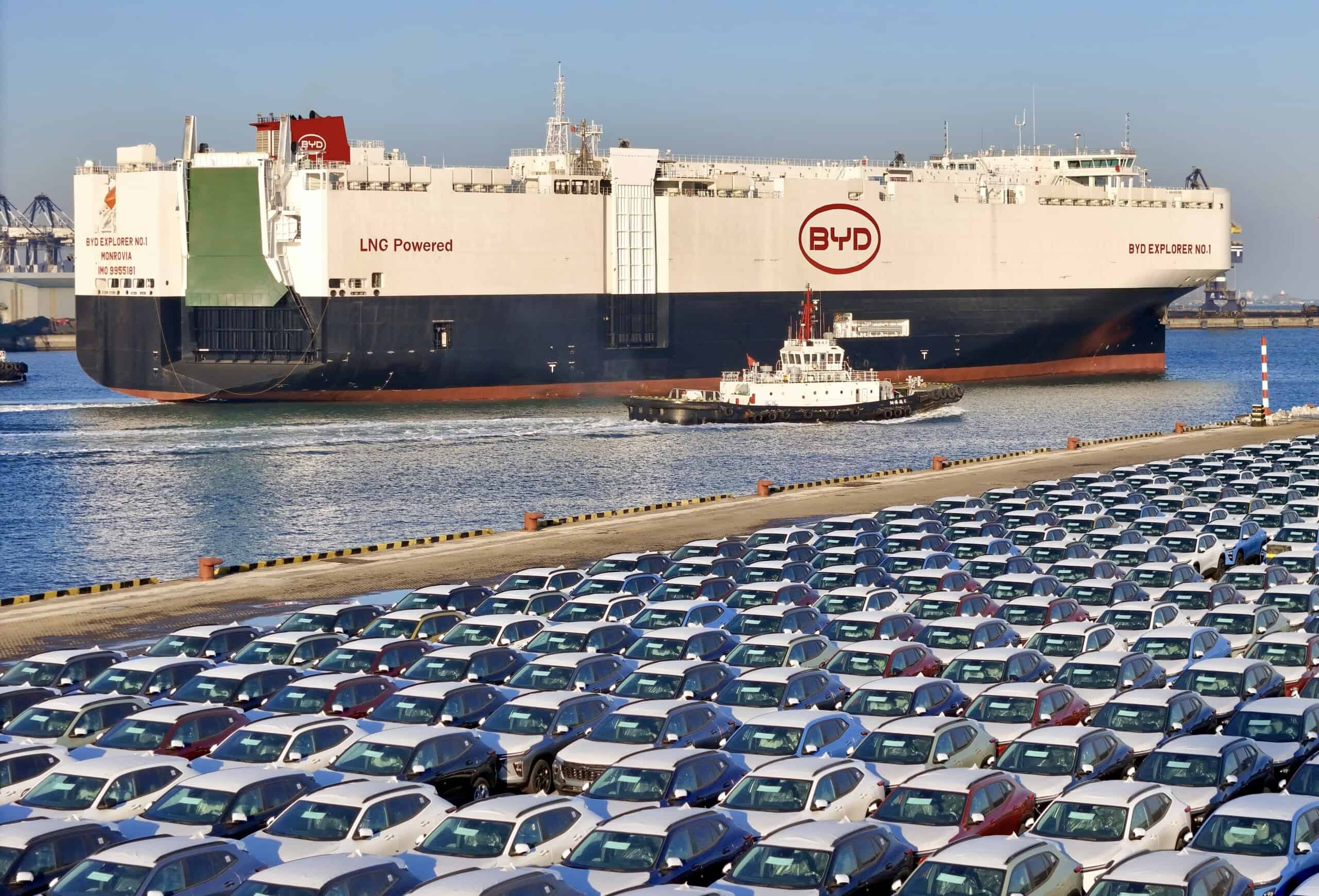
The crisis in the Red Sea is bringing uncertainty and additional costs for ships making the trip from China’s coastal provinces to the export markets of Europe. However, one vessel’s journey along this route in January was greeted with celebration: the maiden voyage of Chinese electric vehicle behemoth BYD’s first cargo ship.
The successful delivery of BYD Explorer No. 1 marks another milestone in the company’s quest for control over all levels of the automotive supply chain. With China now surpassing Japan as the world’s number one auto exporter, the voyage could also set a trend for car companies to take shipping and its associated costs into their own hands, as the supply of vessels globally struggles to keep up with Chinese demand.
This week, The Wire looks at the moves that Chinese auto manufacturers have made to enter the sea freight industry, and examines what changes this could mean for global shipping.
ENTERING THE SHIPPING MARKET
BYD Explorer No.1 set off from Xiaomo port in Shenzhen on January 16 carrying 5,449 vehicles, according to the ship’s manufacturer, China International Marine Containers.
“A company like BYD thinks they have a clear pathway to success, and that this kind of investment is what’s necessary to secure their position internationally,” says Ilaria Mazzocco, senior fellow with the Trustee Chair in Chinese Business and Economics at the Center for Strategic and International Studies (CSIS).
Car companies making forays into shipping is not a new idea; Japanese and Korean auto giants like Nissan and Hyundai have their own logistics arms. But BYD Explorer No.1 is the first Chinese ship built domestically for the exclusive use of a homegrown car company.
“In January, BYD’s new energy vehicle sales were just over 200,000 units. Exports accounted for 36,000 units, so that’s 18 percent of their sales,” says Lei Xing, co-host of the China EVs & More podcast. “We’re seeing domestic sales shifting toward exports, and this is happening for a lot of the companies.”
The rise in China’s auto exports has brought increased demand for vehicle carriers, and supply has struggled to keep pace. The global vehicle carrier fleet amounted to 760 vessels at the end of 2023, up only two percent compared to 2019 levels, according to shipping research firm Clarksons Research.

Auto companies generally use a type of vehicle carrier called a “roll on, roll off” (RORO) ship, meaning cars can be moved on and off using their own wheels instead of relying on a crane.
Renting a RORO ship for one day cost $115,000 on average in 2023, more than seven times the average cost in 2019. A ship’s journey from China to Europe takes at least 30 days under normal conditions, and diversions away from the Red Sea are now extending that time by one to two weeks.
“You do the math: 36,000 vehicles exported and how many trips you make a year with 7,000 cars per carrier, while expecting this export volume to grow. It’s obviously better to have your own ship,” says Xing.

BYD is not the only Chinese company making such investment. In 2023, a joint venture between COSCO, Shanghai International Port Group and SAIC Motors had 24 orders for RORO ships under construction across four shipyards in China, according to specialist shipping website iMarine. By the time all the orders are delivered in 2026, the joint venture, named Guangzhou Yuanhai Car Carrier Transportation, will have a fleet of 30 vessels.
Leading automakers JAC Motors and Chery have also partnered with a state-owned shipping firm in Anhui province to form a car carrier joint venture. Learn more about these joint ventures in the graphic below:

Although BYD’s RORO ship is only a commercial vessel, the People’s Liberation Army has used other such vessels to transport soldiers and equipment, with the first publicly reported example in 2015, according to Xinhua. The U.S. military is critical of this practice because of its potential to blur the distinction between civilian and military vessels in any future conflict.

“By demonstrating intent to use commercial ROROs during an amphibious invasion, the PLA is eroding the principle of distinction under the law of armed conflict,” warns a January 2023 paper issued by U.S. Indo-Pacific Command.
Analysis by think tank CSIS of newly built ROROs show that design improvements are being undertaken with potential dual use applications in mind. In 2019 for example, a COSCO-operated RORO was shown on Chinese state television with a new stern ramp that would allow the ship to launch amphibious combat vehicles.
“That is influencing how companies that build ROROs think about what they might want to build or how they might want to design things in the future,” says Matthew Funaiole, senior fellow at CSIS China Power Project.
While any car company expanding into a new area of business can expect a steep learning curve, BYD has a track record of success when moving beyond simply manufacturing cars. Analysts say it may set up a full-fledged shipping and logistics division in the future.
[BYD has] some experience at doing this — in developing a business line for themselves and making a profit out of it by providing it to others.
Ilaria Mazzocco, senior fellow with the Trustee Chair in Chinese Business and Economics at the Center for Strategic and International Studies (CSIS)
“There is a potential parallel between BYD’s battery production segment. They used to only produce for BYD but recently they’ve actually started supplying other automakers with batteries,” says Mazzocco. “They have some experience at doing this — in developing a business line for themselves and making a profit out of it by providing it to others.”
Read the graphic below to learn more about how BYD’s Explorer No.1 compares to other large RORO ships in terms of capacity:


Aaron Mc Nicholas is a staff writer at The Wire based in Washington DC. He was previously based in Hong Kong, where he worked at Bloomberg and at Storyful, a news agency dedicated to verifying newsworthy social media content. He earned a Master of Arts in Asian Studies at Georgetown University and a Bachelor of Arts in Journalism from Dublin City University in Ireland.




